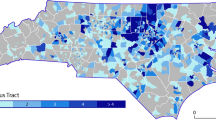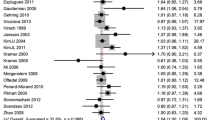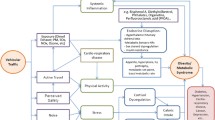Abstract
Associations between traffic-related air pollution and incident childhood asthma can be strengthened by analysis of gene-environment interactions, but studies have typically been limited by lack of study power. We combined data from six birth cohorts on: asthma, eczema and allergic rhinitis to 7/8 years, and candidate genes. Individual-level assessment of traffic-related air pollution exposure was estimated using land use regression or dispersion modeling. A total of 11,760 children were included in the Traffic, Asthma and Genetics (TAG) Study; 6.3 % reported physician-diagnosed asthma at school-age, 16.0 % had asthma at anytime during childhood, 14.1 % had allergic rhinitis at school-age, 10.0 % had eczema at school-age and 33.1 % were sensitized to any allergen. For GSTP1 rs1138272, the prevalence of heterozygosity was 16 % (range amongst individual cohorts, 11–17 %) and homozygosity for the minor allele was 1 % (0–2 %). For GSTP1 rs1695, the prevalence of heterozygosity was 45 % (40–48 %) and homozygosity for the minor allele, 12 % (10–12 %). For TNF rs1800629, the prevalence of heterozygosity was 29 % (25–32 %) and homozygosity for the minor allele, 3 % (1–3 %). TAG comprises a rich database, the largest of its kind, for investigating the effect of genotype on the association between air pollution and childhood allergic disease.

Similar content being viewed by others
Abbreviations
- APMoSPHERE:
-
Air pollution modelling for support to policy on health and environmental risk in Europe
- BAMSE:
-
Children, allergy, Milieu, Stockholm, epidemiological survey
- CAPPS:
-
Canadian asthma primary prevention study
- GINIplus:
-
German infant study on the influence of nutritional intervention plus environmental and genetic influences on allergy development
- GSTP1:
-
Glutathione S-transferase pi 1
- LISAplus:
-
Lifestyle related factors, immune system and the development of allergies in East and West Germany plus the influence of traffic emissions and genetics study
- LUR:
-
Land-use regression
- NO2 :
-
Nitrogen dioxide
- O3 :
-
Ozone
- PIAMA:
-
Prevention and Incidence of asthma and mite allergy
- PM2.5 :
-
Particulate matter of diameter less than 2.5 µm
- SAGE:
-
Study of asthma, genes, and environment
- TAG:
-
Traffic, asthma and genetics study
- TNF:
-
Tumour necrosis factor
- TLR:
-
Toll-like receptor
- TRAP:
-
Traffic-related air pollution
References
Health Effects Institute (2010) Traffic-related air pollution: a critical review of the literature on emissions, exposure and health effects: special report 17.
Braback L, Forsberg B. Does traffic exhaust contribute to the development of asthma and allergic sensitization in children: findings from recent cohort studies. Environ Health. 2009;8:17.
Brauer M, Hoek G, Smit HA, de Jongste JC, Gerritsen J, Postma DS, et al. Air pollution and development of asthma, allergy and infections in a birth cohort. Eur Respir J. 2007;29(5):879–88.
Kim JJ, Smorodinsky S, Lipsett M, Singer BC, Hodgson AT, Ostro B. Traffic-related air pollution near busy roads: the East Bay Children’s Respiratory Health Study. Am J Respir Crit Care Med. 2004;170(5):520–6.
Salam MT, Islam T, Gilliland FD. Recent evidence for adverse effects of residential proximity to traffic sources on asthma. Curr Opin Pulm Med. 2008;14(1):3–8.
Brauer M, Hoek G, van Vliet P, Meliefste K, Fischer P, Gehring U, et al. Estimating long-term average particulate air pollution concentrations: application of traffic indicators and geographic information systems. Epidemiology. 2003;14(2):228–39.
Hoek G, Meliefste K, Cyrys J, Lewné M, Brauer M, Fischer P, et al. Spatial variability of fine particle concentrations in three European countries. Atmos Environ. 2002;36:4077–88.
Allen RW, Amram O, Wheeler A, Brauer M. The transferability of NO and NO2 land use regression models between cities and pollutants. Atmos Environ. 2010;45:369–78.
Henderson SB, Beckerman B, Jerrett M, Brauer M. Application of land use regression to estimate ambient concentrations of traffic-related NOX and fine particulate matter. Environ Sci Tech. 2007;41(7):2422–8.
Carlsten C, Dybuncio A, Becker A, Chan-Yeung M, Brauer M. Traffic-related air pollution and incident asthma in a high-risk birth cohort. Occup Environ Med. 2011;68(4):291–5.
Gehring U, Wijga AH, Brauer M, Fischer P, de Jongste JC, Kerkhof M, et al. Traffic-related air pollution and the development of asthma and allergies during the first 8 years of life. Am J Respir Crit Care Med. 2010;181(6):596–603.
Kramer U, Sugiri D, Ranft U, Krutmann J, von Berg A, Berdel D, et al. Eczema, respiratory allergies, and traffic-related air pollution in birth cohorts from small-town areas. J Dermatol Sci. 2009;56(2):99–105.
Morgenstern V, Zutavern A, Cyrys J, Brockow I, Koletzko S, Kramer U, et al. Atopic diseases, allergic sensitization, and exposure to traffic-related air pollution in children. Am J Respir Crit Care Med. 2008;177(12):1331–7.
Nordling E, Berglind N, Melen E, Emenius G, Hallberg J, Nyberg F, et al. Traffic-related air pollution and childhood respiratory symptoms, function and allergies. Epidemiology. 2008;19(3):401–8.
Salam MT, Lin PC, Avol EL, Gauderman WJ, Gilliland FD. Microsomal epoxide hydrolase, glutathione S-transferase P1, traffic and childhood asthma. Thorax. 2007;62(12):1050–7.
Kelly FJ. Oxidative stress: its role in air pollution and adverse health effects. Occup Environ Med. 2003;60(8):612–6.
Melén E, Nyberg F, Lindgren CM, Berglind N, Zucchelli M, Nordling E, et al. Interactions between glutathione S-transferase P1, tumor necrosis factor, and traffic-related air pollution for development of childhood allergic disease. Environ Health Perspect. 2008;116(8):1077–84.
Schroer KT, Biagini Myers JM, Ryan PH, LeMasters GK, Bernstein DI, Villareal M, et al. Associations between multiple environmental exposures and glutathione S-transferase P1 on persistent wheezing in a birth cohort. J Pediatr. 2009;154(3):401–8, 8 e1.
Carlsten C, Dybuncio A, Becker A, Chan-Yeung M, Brauer M. GSTP1 polymorphism modifies risk for incident asthma associated with nitrogen dioxide in a high-risk birth cohort. Occup Environ Med. 2011;68(4):308.
London SJ. Gene-air pollution interactions in asthma. Proc Am Thorac Soc. 2007;4(3):217–20.
Kozyrskyj AL, HayGlass KT, Sandford AJ, Pare PD, Chan-Yeung M, Becker AB. A novel study design to investigate the early-life origins of asthma in children (SAGE study). Allergy. 2009;64(8):1185–93.
Wickman M, Kull I, Pershagen G, Nordvall SL. The BAMSE project: presentation of a prospective longitudinal birth cohort study. Pediatr Allergy Immunol. 2002;13(Suppl 15):11–3.
Gehring U, Cyrys J, Sedlmeir G, Brunekreef B, Bellander T, Fischer P, et al. Traffic-related air pollution and respiratory health during the first 2 yrs of life. Eur Respir J. 2002;19(4):690–8.
Koopman LP, van Strien RT, Kerkhof M, Wijga A, Smit HA, de Jongste JC, et al. Placebo-controlled trial of house dust mite-impermeable mattress covers: effect on symptoms in early childhood. Am J Respir Crit Care Med. 2002;166(3):307–13.
Lewné M, Cyrys J, Meliefste K, Brauer M, Fischer P, Gehring U, et al. Spatial variation of outdoor nitrogen dioxide in Munich (Germany), the Netherlands and Stockholm County (Sweden). Sci Total Environ. 2004;332:217–30.
Hochadel M, Heinrich J, Gehring U, Morgenstern V, Kuhlbusch T, Link E, et al. Predicting long-term average concentrations of traffic-related air pollutants using GIS-based information. Atmos Environ. 2006;40:542–53.
Bellander T, Berglind N, Gustavsson P, Jonson T, Nyberg F, Pershagen G, et al. Using geographic information systems to assess individual historical exposure to air pollution from traffic and house heating in Stockholm. Environ Health Perspect. 2001;109(6):633–9.
Beelen R, Hoek G, Pebesma E, Vienneau D, de Hoogh K, Briggs DJ. Mapping of background air pollution at a fine spatial scale across the European Union. Sci Total Environ. 2009;407(6):1852–67.
Bauer M, Herbarth O, Aust G, Hengstler JG, Dotzauer A, Graebsch C, et al. Expression patterns and novel splicing variants of glutathione-S-transferase isoenzymes of human lung and hepatocyte cell lines. Cell Tissue Res. 2006;324(3):423–32.
Ren C, Vokonas PS, Suh H, Fang S, Christiani DC, Schwartz J. Effect modification of air pollution on Urinary 8-Hydroxy-2’-Deoxyguanosine by genotypes: an application of the multiple testing procedure to identify significant SNP interactions. Environ Health. 2010;9:78.
Yang IA, Fong KM, Zimmerman PV, Holgate ST, Holloway JW. Genetic susceptibility to the respiratory effects of air pollution. Thorax. 2008;63(6):555–63.
Brunekreef B. Health effects of air pollution observed in cohort studies in Europe. J Expo Sci Environ Epidemiol. 2007;17(Suppl 2):S61–5.
Emenius G, Pershagen G, Berglind N, Kwon HJ, Lewne M, Nordvall SL, et al. NO2, as a marker of air pollution, and recurrent wheezing in children: a nested case-control study within the BAMSE birth cohort. Occup Environ Med. 2003;60(11):876–81.
Eeftens M, Beelen R, Fischer P, Brunekreef B, Meliefste K, Hoek G. Stability of measured and modelled spatial contrasts in NO(2) over time. Occup Environ Med. 2011;68(10):765–70.
Madsen C, Gehring U, Håberga SE, Nafstad P, Meliefste K, Nystad W, et al. Comparison of land-use regression models for predicting spatial NOx contrasts over a three year period in Oslo, Norway. Atmos Environ. 2011;45(21):3576–83.
Wang R. Assessment of the temporal stability of land use regression models for traffic-related air pollution. Kelowna: University of British Columbia; 2011.
Blettner M, Sauerbrei W, Schlehofer B, Scheuchenpflug T, Friedenreich C. Traditional reviews, meta-analyses and pooled analyses in epidemiology. Int J Epidemiol. 1999;28(1):1–9.
Vrijheid M, Casas M, Bergstrom A, Carmichael A, Cordier S, Eggesbo M, et al. European birth cohorts for environmental health research. Environ Health Perspect. 2012;120(1):29–37.
Acknowledgments
Initial discussions regarding the TAG collaboration took place at the AllerGen NCE workshop “Genes and the Environment: The Genesis of Asthma and Allergy” in 2009. We thank Dr. Kees de Hoogh for providing the ozone exposure estimates from the APMoSPHERE project. We would like to thank all children and parents for their cooperation. We would also like to thank all technical and administrative support staff and the medical and fieldwork teams. Funding for this project (the TAG study) was provided by the AllerGen NCE (The Allergy, Genes and Environment Network). The BAMSE study was supported by the Swedish Research Council, the Swedish Research Council FORMAS, the Swedish Heart–Lung Foundation, Stiftelsen Frimurare Barnhuset i Stockholm, the Stockholm County Council, the Swedish Environmental Protection Agency, and the Swedish Society for Medical Research. The PIAMA study is supported by The Netherlands Organization for Health Research and Development, The Netherlands Organization for Scientific Research, The Netherlands Asthma Fund, The Netherlands Ministry of Spatial Planning, Housing, and the Environment, and The Netherlands Ministry of Health, Welfare, and Sport. The GINIplus study was mainly supported for the first 3 years of the Federal Ministry for Education, Science, Research and Technology (interventional arm) and Helmholtz Zentrum Munich (former GSF) (observational arm). The 6 year follow-up examination of the GINIplus study was covered from the respective budgets of the 5 study centres (Helmholtz Zentrum Munich (former GSF), Marien-Hospital Wesel, LMU Munich, TU Munich and from 6 years onwards also from IUF—Leibniz Research-Institute for Environmental Medicine, Düsseldorf) and a grant from the Federal Ministry for Environment (IUF Düsseldorf, FKZ 20462296). The LISAplus study was mainly supported by grants from the Federal Ministry for Education, Science, Research and Technology and in addition from Helmholtz Zentrum Munich (former GSF), Helmholtz Centre for Environmental Research—UFZ, Leipzig, Marien-Hospital Wesel, Pediatric Practice, Bad Honnef for the first 2 years. The 6 year follow-up examination of the LISAplus study was covered from the respective budgets of the involved partners (Helmholtz Zentrum Munich (former GSF), Helmholtz Centre for Environmental Research—UFZ, Leipzig, Marien-Hospital Wesel, Pediatric Practice, Bad Honnef, IUF—Leibniz-Research Institute for Environmental Medicine, Düsseldorf) and in addition by a grant from the Federal Ministry for Environment (IUF Düsseldorf, FKZ 20462296). The CAPPS study was supported by the Canadian Institute of Health Research, the British Columbia Lung Association, and the Manitoba Medical Service Foundation. The SAGE study was supported by the Canadian Institute of Health Research. Elaine Fuertes was supported by the AllerGen NCE (Canadian Allergy and Immune Diseases Advanced Training Initiative) and the Canadian Institutes of Health Research (Sir Frederick Banting and Charles Best Canada Graduate Scholarship).
Author information
Authors and Affiliations
Corresponding author
Additional information
This study was conducted for the TAG Study Group
Electronic supplementary material
Below is the link to the electronic supplementary material.
Rights and permissions
About this article
Cite this article
MacIntyre, E.A., Carlsten, C., MacNutt, M. et al. Traffic, asthma and genetics: combining international birth cohort data to examine genetics as a mediator of traffic-related air pollution’s impact on childhood asthma. Eur J Epidemiol 28, 597–606 (2013). https://doi.org/10.1007/s10654-013-9828-5
Received:
Accepted:
Published:
Issue Date:
DOI: https://doi.org/10.1007/s10654-013-9828-5




